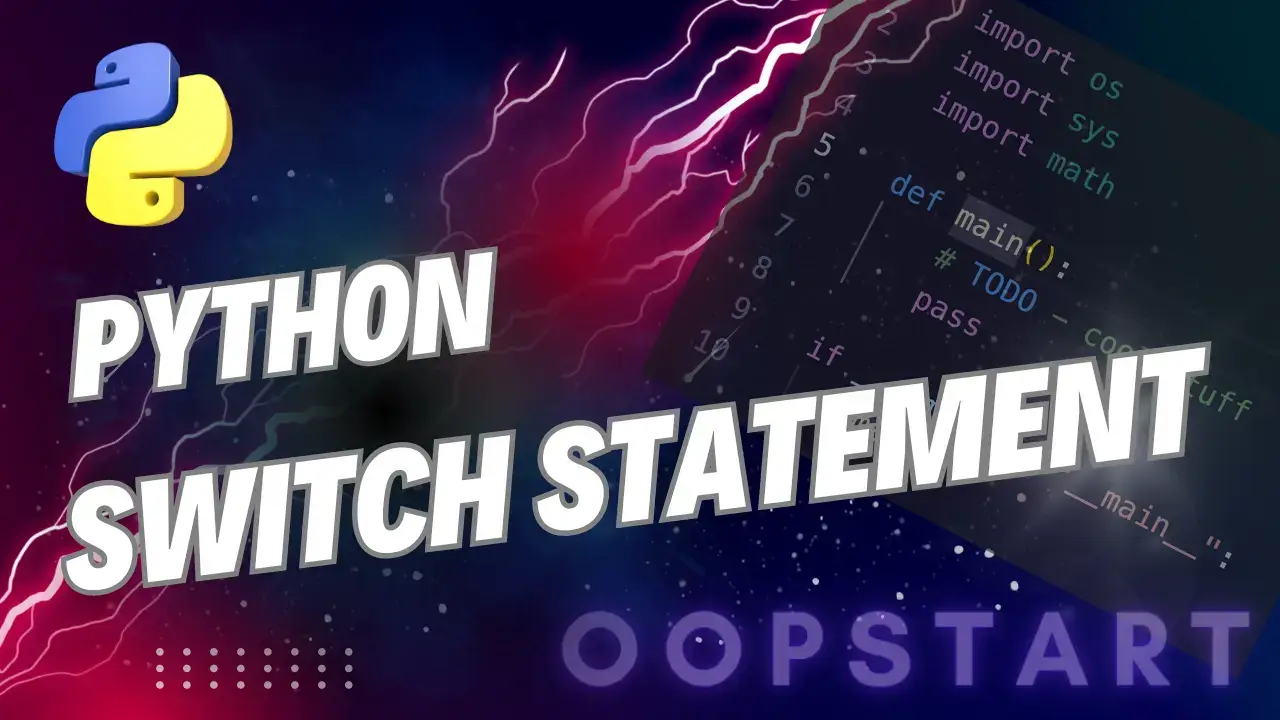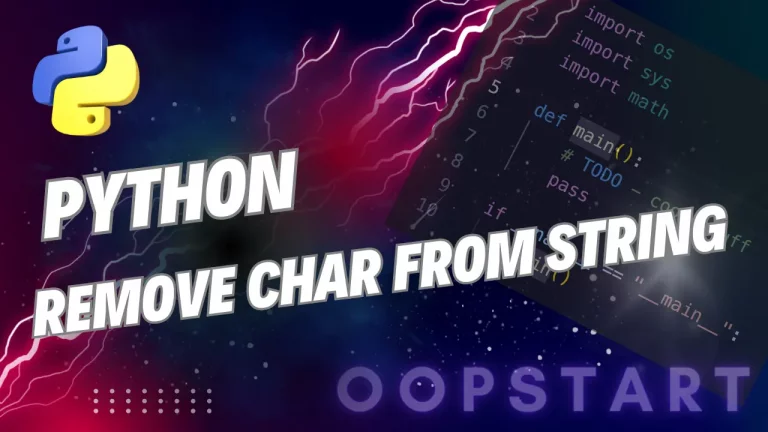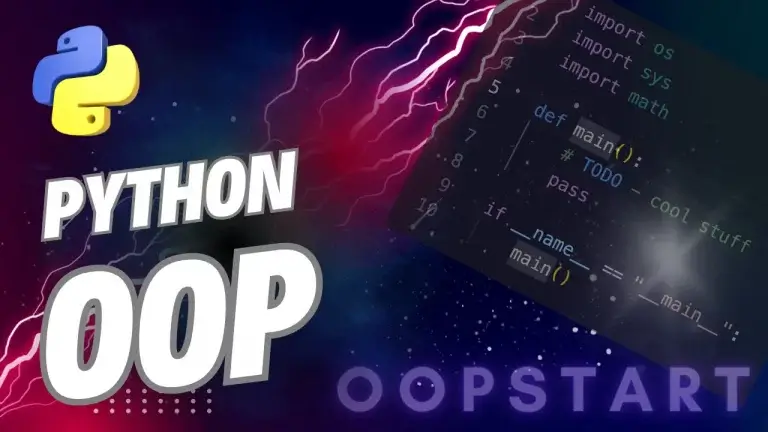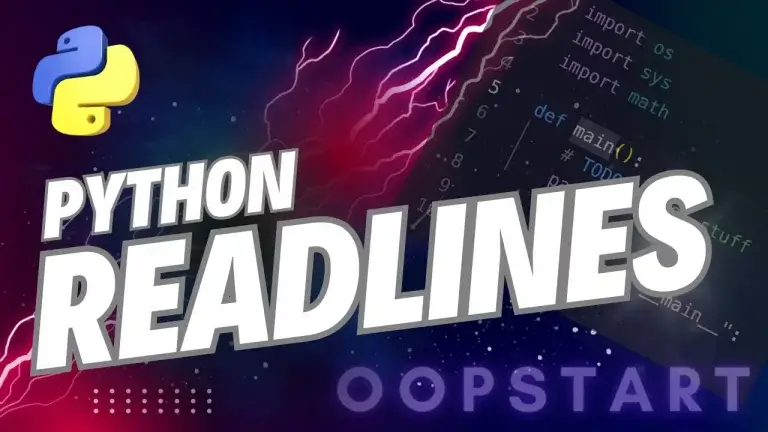Python Switch Statement: Full Guide
A switch statement is a common programming construct in many languages, like C, Java, and JavaScript, where a variable is tested against a list of possible values, and corresponding code blocks are executed.
However, there is no native Python switch statement.
Instead, Python uses alternatives like if-elif-else chains or more advanced structures like dictionaries, functions, or match statements (introduced in Python 3.10) to achieve similar behavior.
By the end of this guide, you’ll understand how to implement a Python switch statement using various Pythonic idioms.
Table of Contents
Why Python Doesn’t Have a Native Switch Statement
Python’s philosophy emphasizes simplicity and readability, often favoring concise code constructs. The if-elif-else structure in Python is already capable of handling multiple conditional branches, making it easy to replicate switch-like behavior. Adding a switch statement was deemed unnecessary by Python’s designers, as the if-elif-else construct is both readable and versatile.
However, Python developers have adopted different techniques to simulate switch statements when needed, ensuring flexibility while maintaining the simplicity of Python’s syntax.
Alternatives to a Switch Statement in Python
1. Using if-elif-else Statements
The simplest and most common alternative to a switch statement in Python is using if-elif-else statements. This structure is straightforward and covers most use cases.
Example: Using if-elif-else
def switch_example(option):
if option == 1:
return "Option 1 selected"
elif option == 2:
return "Option 2 selected"
elif option == 3:
return "Option 3 selected"
else:
return "Invalid option"
print(switch_example(2)) # Output: Option 2 selected
In this example, the function mimics the behavior of a switch statement by evaluating different if and elif conditions. While this works well for simple cases, it can become less readable if there are many conditions.
2. Using Dictionary Mapping for a Switch Statement
Another elegant way to simulate a switch statement in Python is by using dictionaries. You can map each case to a corresponding value or function, which makes the code cleaner and more maintainable for larger switch-like structures.
Example: Using a Dictionary
def switch_using_dict(option):
switcher = {
1: "Option 1 selected",
2: "Option 2 selected",
3: "Option 3 selected"
}
return switcher.get(option, "Invalid option")
print(switch_using_dict(2)) # Output: Option 2 selected
In this example, the dictionary switcher acts like a switch statement by mapping different options (keys) to the respective outcomes (values). The get() method is used to return a default value if the key is not found (i.e., the “Invalid option”).
3. Using Functions in Dictionary Mapping
You can take the dictionary approach a step further by associating each case with a function. This method is useful when the actions associated with each case involve more complex logic than returning a simple value.
Example: Using Functions in a Dictionary
def option1():
return "Executing Option 1"
def option2():
return "Executing Option 2"
def option3():
return "Executing Option 3"
def switch_using_func_dict(option):
switcher = {
1: option1,
2: option2,
3: option3
}
# Call the function mapped to the option
return switcher.get(option, lambda: "Invalid option")()
print(switch_using_func_dict(1)) # Output: Executing Option 1
In this approach, each option is mapped to a function, allowing more complex operations to be performed. The get() method returns a default lambda function for invalid options.
4. Using the match Statement (Python 3.10+)
Starting from Python 3.10, Python introduces a match statement, which is similar to switch statements in other languages. It offers more powerful pattern matching capabilities and is more versatile than traditional switch statements.
Syntax:
match subject:
case pattern1:
# Code block for pattern1
case pattern2:
# Code block for pattern2
case _:
# Default code block
Example: Using match
def switch_with_match(option):
match option:
case 1:
return "Option 1 selected"
case 2:
return "Option 2 selected"
case 3:
return "Option 3 selected"
case _:
return "Invalid option"
print(switch_with_match(2)) # Output: Option 2 selected
In this example, match evaluates the option and executes the code block corresponding to the matched pattern. The _ case is the default case, equivalent to else in if-elif-else statements or default in a switch statement from other languages.
When to Use Each Approach
1. if-elif-else:
Use this approach when the number of conditions is small and when each case requires different comparison logic. It’s also best for scenarios where readability is more important than optimization.
2. Dictionary Mapping:
This method is ideal for simple lookups where you map options to outcomes directly. It’s also useful for improving the readability and scalability of code. Dictionary-based switch statements are ideal for large sets of options, especially when the values are simple and fixed.
3. Dictionary Mapping with Functions:
Use this approach when each case requires different operations or functions. This method is best suited for complex applications where different behaviors are triggered based on the option.
4. match (Python 3.10+):
This is the most flexible and powerful method, allowing you to match patterns, not just values. It’s best for scenarios involving complex matching and more structured pattern matching, such as working with data classes or nested structures.
Use Cases for Python Switch Statements
1. Menu-Based Programs
If you’re building a menu-based program where users select options from a list, you can implement a switch-like structure to handle different commands or actions based on user input.
Example:
def menu_choice(option):
match option:
case 1:
print("Starting new game...")
case 2:
print("Loading saved game...")
case 3:
print("Exiting game.")
case _:
print("Invalid choice.")
# Simulating user input
menu_choice(1) # Output: Starting new game...
2. Command Dispatching
Switch statements are often used to dispatch commands to functions or operations. Python’s dictionary-based approach can make command dispatching cleaner and more scalable.
Example:
def start_game():
print("Starting game...")
def load_game():
print("Loading game...")
def exit_game():
print("Exiting game...")
commands = {
"start": start_game,
"load": load_game,
"exit": exit_game
}
# Execute the command based on user input
command = "start"
commands.get(command, lambda: print("Unknown command"))()
Common Pitfalls and How to Avoid Them
1. Using match in Older Versions of Python
The match statement is only available starting from Python 3.10. If you try to use it in earlier versions, you will get a syntax error. Ensure that you are using Python 3.10 or later if you plan to implement the match statement.
Solution:
Check your Python version before using match:
python --version
2. Using Mutable Types as Dictionary Keys
If you’re using dictionaries to simulate a switch statement, ensure that the keys are immutable types (such as integers, strings, or tuples). Using mutable types like lists as dictionary keys will raise an error.
3. Not Providing a Default Case
Always provide a default case when using a dictionary or match statement to handle invalid inputs gracefully. Failing to do this may result in errors if the input doesn’t match any case.
Best Practices for Replacing Switch Statements in Python
- Choose the Right Method: For simple use cases, stick with
if-elif-elsestatements. For more complex, structured data, consider usingmatch(if on Python 3.10+). - Use Functions for Reusability: If your switch cases involve repetitive code, use functions to keep your code DRY (Don’t Repeat Yourself).
- Use Dictionary Mapping for Readability: Dictionary mappings are clean and effective for large sets of simple conditions. Use them when there’s a direct mapping between keys and outcomes or functions.
- Handle Edge Cases: Always account for unexpected inputs by including default cases in your
if-elif-else, dictionary, ormatchstatement.
Summary of Key Concepts
- Python doesn’t have a native switch statement, but alternatives like
if-elif-else, dictionaries, and thematchstatement (Python 3.10+) can be used to achieve similar functionality. if-elif-elseis simple and widely used for smaller sets of conditions.- Dictionaries offer a clean, scalable way to simulate switch statements, especially for mappings between options and values or functions.
matchintroduces pattern matching in Python 3.10+, allowing more complex and flexible switch-like behavior.- Always provide a default case to handle unexpected input.
Exercises
- Dictionary-Based Switch: Write a Python program that uses a dictionary to simulate a switch statement. The program should take a user input (e.g., 1, 2, or 3) and print corresponding messages.
- Function-Based Switch: Modify the program to map each case to a function and execute the appropriate function based on user input.
- Using
matchStatement: If you are using Python 3.10 or later, write a program using thematchstatement to handle multiple cases and a default fallback.
Check out our FREE Learn Python Programming Masterclass to hone your skills or learn from scratch.
The course covers everything from first principles to Graphical User Interfaces and Machine Learning
For obvious reasons, the official Python documentation has no entry for a Python switch statement 🙂
FAQ
Q1: Why doesn’t Python have a native switch statement?
A1: Python emphasizes simplicity and readability. The if-elif-else structure is considered versatile enough to handle multiple conditional branches. Python’s designers decided that adding a switch statement would be redundant, as most use cases are already covered by existing structures. Moreover, with the introduction of the match statement in Python 3.10, Python gained a more powerful pattern-matching tool, further reducing the need for a traditional switch statement.
Q2: Can I use the match statement in Python versions earlier than 3.10?
A2: No, the match statement was introduced in Python 3.10 and is not available in earlier versions. If you’re using Python 3.9 or earlier, you will need to use alternatives like if-elif-else, dictionary mappings, or function-based approaches to replicate the behavior of a switch statement.
To use match, ensure you’re running Python 3.10 or higher by checking your version:
python --version
Q3: What are the advantages of using a dictionary to simulate a switch statement?
A3: Using a dictionary to simulate a switch statement in Python has several advantages:
- Readability: Dictionary mappings are clear and concise, especially for simple lookups.
- Scalability: For large sets of conditions, dictionary mappings are easier to maintain than long
if-elif-elsechains. - Efficiency: Dictionary lookups are faster than evaluating multiple
ifconditions, especially with a large number of options. - Flexibility: You can map dictionary keys to functions, allowing more complex operations to be executed based on input values.
Q4: Can I use non-integer types as keys in a dictionary-based switch?
A4: Yes, in Python, dictionary keys can be any immutable data type, such as strings, integers, tuples, or even other objects. This makes dictionary-based switch statements flexible and useful in various situations where conditions aren’t limited to integers.
Example using strings as keys:
def switch_with_strings(option):
switcher = {
"start": "Starting the process...",
"stop": "Stopping the process...",
"pause": "Pausing the process..."
}
return switcher.get(option, "Invalid option")
print(switch_with_strings("start")) # Output: Starting the process...
Q5: How do I handle cases where the same action should be taken for multiple inputs in a switch?
A5: When multiple inputs require the same action, you can group them by using functions or by reusing values in a dictionary. For example, you can create a function that handles multiple cases or use a common function for multiple dictionary keys.
Example using a common function:
def default_action():
return "Default action for multiple inputs"
def switch_with_common_action(option):
switcher = {
1: default_action,
2: default_action,
3: lambda: "Unique action for 3"
}
return switcher.get(option, lambda: "Invalid option")()
print(switch_with_common_action(1)) # Output: Default action for multiple inputs
print(switch_with_common_action(3)) # Output: Unique action for 3
Q6: Can I pass arguments to functions when using dictionary-based switch statements?
A6: Yes, you can pass arguments to functions in a dictionary-based switch statement by using lambda functions or wrapping the function calls in another function. This allows you to provide dynamic values to the functions being called.
Example:
def greet(name):
return f"Hello, {name}!"
def farewell(name):
return f"Goodbye, {name}!"
def switch_with_arguments(option, name):
switcher = {
1: lambda: greet(name),
2: lambda: farewell(name)
}
return switcher.get(option, lambda: "Invalid option")()
print(switch_with_arguments(1, "Alice")) # Output: Hello, Alice!
print(switch_with_arguments(2, "Bob")) # Output: Goodbye, Bob!
Q7: How can I implement a switch statement that checks for ranges (e.g., 1-10, 11-20) rather than exact values?
A7: You can’t directly implement range-based checks using dictionary mappings or match. However, you can use the if-elif-else approach or loop over dictionary keys and check for ranges within a function.
Example using if-elif-else:
def range_switch(number):
if 1 <= number <= 10:
return "Number is between 1 and 10"
elif 11 <= number <= 20:
return "Number is between 11 and 20"
else:
return "Number is out of range"
print(range_switch(15)) # Output: Number is between 11 and 20
Q8: Can I use the match statement for complex data types like tuples or lists?
A8: Yes, the match statement introduced in Python 3.10 allows pattern matching for complex data types like tuples, lists, and even custom objects. This makes it much more powerful than a traditional switch statement found in other languages.
Example using tuples:
def match_complex_data(data):
match data:
case (1, "apple"):
return "Matched (1, 'apple')"
case (2, "banana"):
return "Matched (2, 'banana')"
case _:
return "No match"
print(match_complex_data((1, "apple"))) # Output: Matched (1, 'apple')
Q9: What’s the performance difference between using if-elif-else and dictionary-based switches?
A9: In general, dictionary-based switch statements are faster than if-elif-else chains, especially when dealing with many conditions. This is because dictionary lookups are performed in constant time (O(1)), whereas if-elif-else statements require evaluating each condition sequentially, resulting in linear time (O(n)) performance as the number of conditions grows.
For small sets of conditions, the performance difference may be negligible, but for large datasets, dictionary-based approaches tend to be more efficient.
Q10: Can I use match statements for partial matching or fuzzy matching?
A10: No, the match statement in Python 3.10+ is designed for strict pattern matching, meaning that it will only match if the pattern exactly fits the structure of the data being matched. If you need partial or fuzzy matching, you’ll need to implement custom logic using if-elif-else or other Python constructs.








